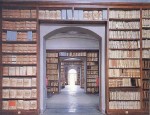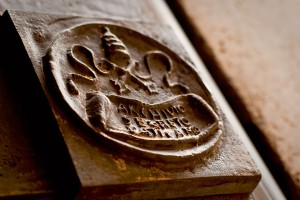 But aren’t they always in Rome, you ask? Geographically yes, but politically the Vatican Secret Archives, the Pope’s private document library and subject of much Dan Brown-based intrigue, have never left the confines of Vatican City before. A hundred handpicked documents covering a thousand years of history on all continents will go on display at Rome’s Capitoline Museums from February to September, 2012, to mark the 400th anniversary of the archive’s founding.
But aren’t they always in Rome, you ask? Geographically yes, but politically the Vatican Secret Archives, the Pope’s private document library and subject of much Dan Brown-based intrigue, have never left the confines of Vatican City before. A hundred handpicked documents covering a thousand years of history on all continents will go on display at Rome’s Capitoline Museums from February to September, 2012, to mark the 400th anniversary of the archive’s founding.
The Archivum Secretum Vaticanum was created by Pope Paul V in 1612. Unlike the Vatican Library, they were the personal archives of the Pope, not a Church department administered by the Curia. In fact its description as “Secretum,” which now has such a delicious air of conspiracy, in its ancient usage connotes privacy, not secrecy. The Secret Archive remained the private domain of the Papacy until 1881, when Pope Leo XIII opened the doors to scholars.
Today the 52 miles of shelves holding primary documents and historical texts going back 1500 years remain available to researchers, but they have to go to the Vatican to peruse them. Come February, some of those documents marking history’s most momentous events, will be shown to the public and they will be shown on the Capitoline Hill, the secular civic center of Rome for thousands of years. That’s two big firsts: the first time the Papacy’s personal archive is opened to public view, and the first time the Vatican is making a loan to a museum in the city of Rome.
The oldest document on display will be the “Dictatus Papae” issued by Pope Gregory VII in 1075 (there’s some debate on the date). It’s a list of 27 axioms that form the basis of papal supremacy. The 1245 bull of deposition of Frederick II in which Pope Innocent IV excommunicated the Holy Roman Emperor for defying that supremacy is also part of the exhibit.
 My favorite piece is a letter sent to Pope Clement VII in 1530 by over 80 England lords, bishops and cardinals, asking the Pope to get cracking on annulling the marriage between Henry VIII and Catherine of Aragon. Henry VIII had first asked the Pope to annul the marriage in 1527, the same year that Emperor Charles V, Catherine’s nephew, sacked Rome and imprisoned the Pope. Even after Clement returned to Rome in 1528, he was still very much under pressure from Charles. The letter was an attempt to goose Clement out of his frozen posture. It was written on parchment and has long trailing ribbons containing all the red wax seals of England’s peerage. Clement was not impressed with its undeniable coolness. He thought it presumptuous of the nobles to complain about the delay and he didn’t much appreciate the implication that England would respond to a refusal with extreme measures.
My favorite piece is a letter sent to Pope Clement VII in 1530 by over 80 England lords, bishops and cardinals, asking the Pope to get cracking on annulling the marriage between Henry VIII and Catherine of Aragon. Henry VIII had first asked the Pope to annul the marriage in 1527, the same year that Emperor Charles V, Catherine’s nephew, sacked Rome and imprisoned the Pope. Even after Clement returned to Rome in 1528, he was still very much under pressure from Charles. The letter was an attempt to goose Clement out of his frozen posture. It was written on parchment and has long trailing ribbons containing all the red wax seals of England’s peerage. Clement was not impressed with its undeniable coolness. He thought it presumptuous of the nobles to complain about the delay and he didn’t much appreciate the implication that England would respond to a refusal with extreme measures.
The complete minutes from Galileo Galilei’s 1633 trial, signed by Galileo himself and including his scientific manuscripts, will be on display, as well as two letters that are remarkable perhaps less for their content and more for their material. One is a letter written by Empress Helena of China to Innocent X on silk. The other is inscribed on birch bark and was sent to Pope Leo XIII in 1887 by the Ojibwe Indians of Ontario, Canada who address the pope as “Great Master of Prayer, he who holds the place of Jesus.”
 The exhibit doesn’t shy entirely away from more contemporary controversies. Documents describing the World War I-era genocide of Armenians by Ottoman Turkey are included, as are some pieces about Pius XII during World War. The latter is quite the shocker given that documents in the Archive are only currently authorized for perusal up until February 1939, the end of Pius XI’s papacy. Pius XII’s reputation has been tarnished by his public silence on the Holocaust and working relationship with Nazi dictatorship, but the Vatican hasn’t allowed historians to study his records because they are in a “closed period,” the time when access is shut down so Vatican archivists can spend years cataloging and collating.
The exhibit doesn’t shy entirely away from more contemporary controversies. Documents describing the World War I-era genocide of Armenians by Ottoman Turkey are included, as are some pieces about Pius XII during World War. The latter is quite the shocker given that documents in the Archive are only currently authorized for perusal up until February 1939, the end of Pius XI’s papacy. Pius XII’s reputation has been tarnished by his public silence on the Holocaust and working relationship with Nazi dictatorship, but the Vatican hasn’t allowed historians to study his records because they are in a “closed period,” the time when access is shut down so Vatican archivists can spend years cataloging and collating.
At the press conference about the exhibit, Bishop Sergio Pagano, Prefect of the Vatican Secret Archives, said that the Armenian genocide documents “cause an irrepressible sense of pain and horror” that “make [him] ashamed to be a man,” and that the documents will soon be published in a single volume. He also noted that he thinks the Pius XII archives will be opened over the next two or three years.